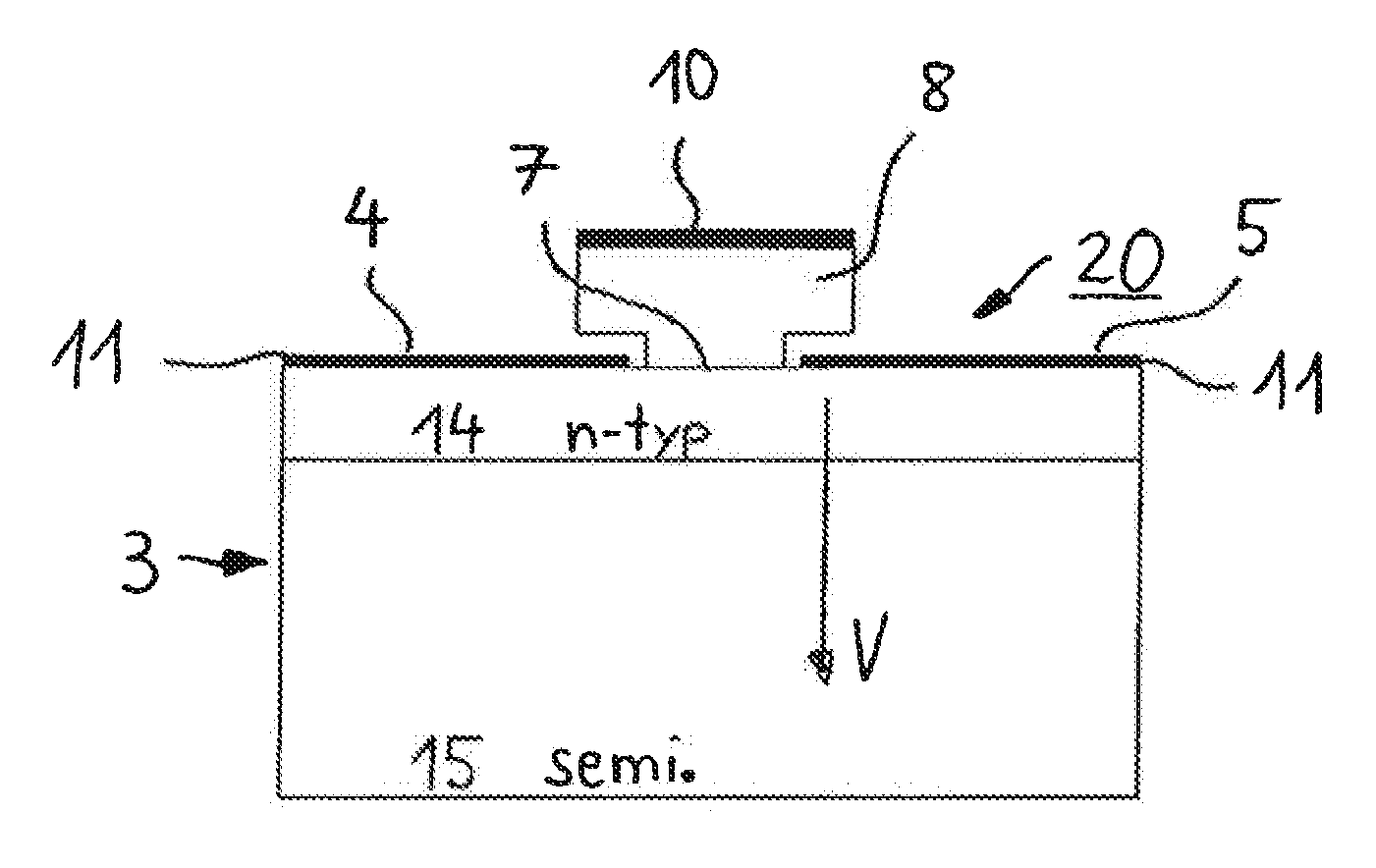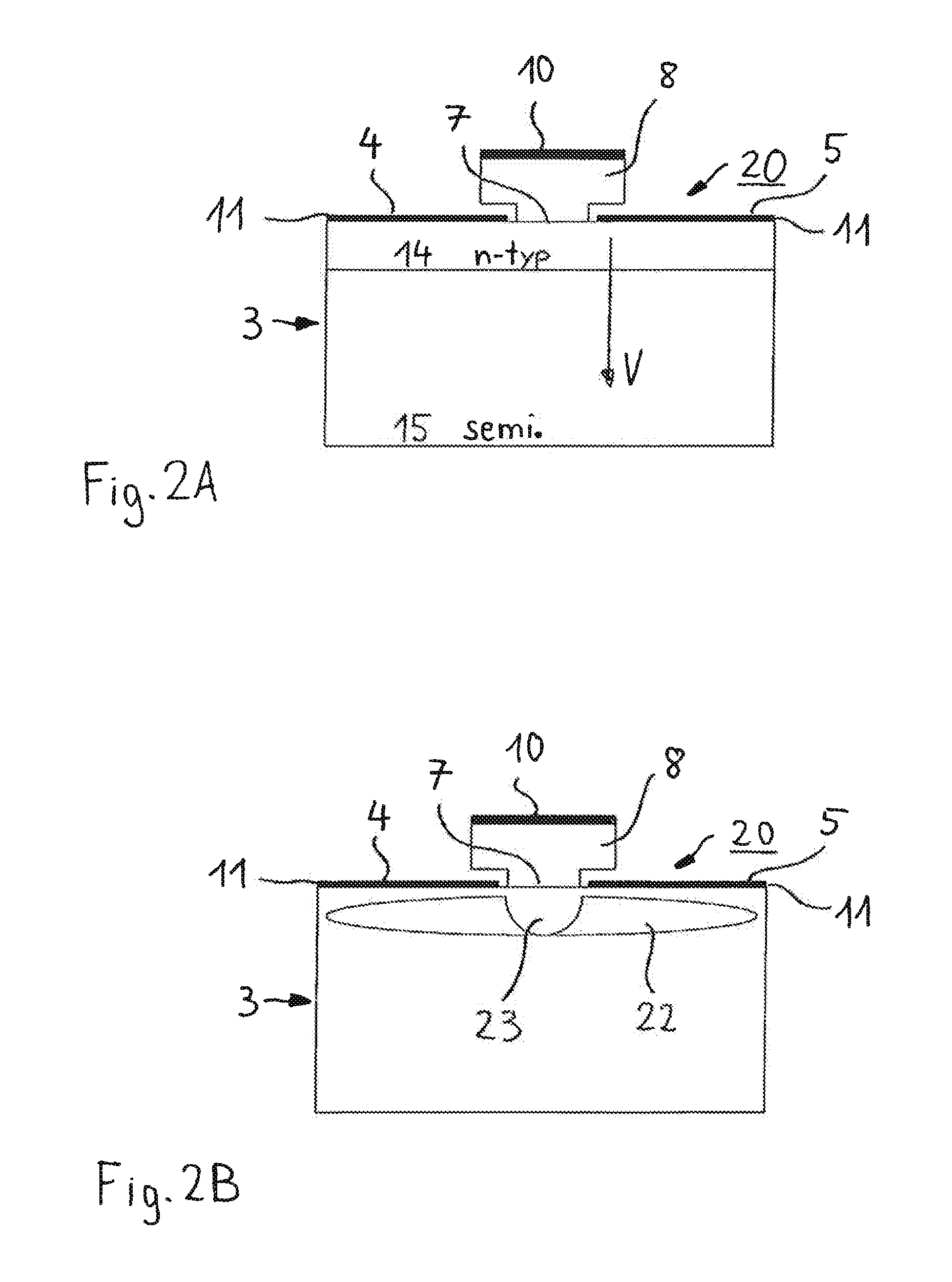Semiconductor component
a technology of semiconductors and components, applied in the field of semiconductor components, can solve the problems of inability to obtain a high on/off ratio, complex production of previously designed components, and electrodes no longer contributing to the conductivity, and achieve the effect of simple production
- Summary
- Abstract
- Description
- Claims
- Application Information
AI Technical Summary
Benefits of technology
Problems solved by technology
Method used
Image
Examples
first embodiment
[0045]FIG. 1A schematically illustrates a cross section of a semiconductor component 1 in accordance with a first embodiment variant. The semiconductor component 1 comprises a semiconductor substrate 3 composed of silicon carbide, to the surface of which a source electrode 4 and a drain electrode 5 separate therefrom are applied. In an exposed intermediate region 7 of the semiconductor substrate 3 between the source electrode 4 and the drain electrode 5, a gate stack is formed by a dielectric 8, on the top side of which a gate electrode 10 is arranged.
[0046]The source electrode 4 and the drain electrode 5 comprise at least one monolayer of epitaxial graphene 11 grown on a surface of the silicon carbide crystal. By way of example, the surface of the silicon carbide is a (0001) surface. The at least one monolayer of epitaxial graphene 11 is produced on the surface of the silicon carbide by thermal decomposition of the silicon carbide. The two electrodes 4, 5 are subsequently produced ...
second embodiment
[0053]FIG. 2A illustrates a semiconductor component 20 in accordance with a second embodiment variant in a cross section. In this case, identical reference signs designate identical parts.
[0054]In a manner corresponding to FIG. 1A, the semiconductor component 20 in accordance with FIG. 2A also comprises a semiconductor substrate 3 composed of silicon carbide, to the surface of which a source electrode 4 and a drain electrode 5 are applied, which comprise at least one monolayer of epitaxial graphene 11 on the silicon carbide surface. The electrodes 4, 5 of the semiconductor component 20 according to FIG. 2A are likewise produced by means of thermal decomposition of the surface of the silicon carbide.
[0055]A gate stack comprising a dielectric 8 and a gate electrode 10 applied thereto is once again arranged in an intermediate region 7 between the source electrode 4 and the drain electrode 5.
[0056]Like FIG. 1A, the semiconductor substrate 3 of the semiconductor component 20 according to...
third embodiment
[0059]FIG. 3 illustrates a semiconductor component 30 in accordance with a third embodiment variant in a plan view and in a cross section. In this case, identical parts are once again provided with identical reference signs.
[0060]In the case of the semiconductor component 30 in accordance with FIG. 3, the semiconductor substrate 3 likewise has a vertical n-p junction beneath the electrodes 4, 5. A space charge zone SCZ arises which extends far into the first, n-conducting region 14 of the silicon carbide. The doping concentrations and the vertical thicknesses of the regions 14, 15 can vary relative to the semiconductor component 1 illustrated in FIG. 1.
[0061]In contrast to the semiconductor component 1 illustrated in FIG. 1, no dielectric 8 is applied in the intermediate region 7 between the source electrode 4 and the drain electrode 5. Rather, an electrochemical electrode is used as a gate electrode 10. For this purpose, a drop of an ionic liquid 31 is applied between the two elect...
PUM
 Login to View More
Login to View More Abstract
Description
Claims
Application Information
 Login to View More
Login to View More - R&D
- Intellectual Property
- Life Sciences
- Materials
- Tech Scout
- Unparalleled Data Quality
- Higher Quality Content
- 60% Fewer Hallucinations
Browse by: Latest US Patents, China's latest patents, Technical Efficacy Thesaurus, Application Domain, Technology Topic, Popular Technical Reports.
© 2025 PatSnap. All rights reserved.Legal|Privacy policy|Modern Slavery Act Transparency Statement|Sitemap|About US| Contact US: help@patsnap.com



